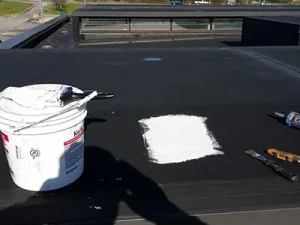
Flat roofs are a common choice for commercial buildings and modern residential homes in Shelby due to their sleek appearance, ease of installation, and cost-effective design. However, flat roofs also come with unique maintenance requirements and vulnerabilities. Unlike pitched roofs, they don’t shed water easily, which can lead to pooling, leaks, and structural damage over time. When issues arise, timely flat roof repair is essential to prevent further deterioration and protect your building from costly interior damage. Call First Class Roofing, serving Shelby, OH today on 888-699-9321 to speak with us.
Signs Your Flat Roof Needs Repair
Flat roofs may appear simple on the surface, but spotting problems early requires attention to detail. Here are the most common signs your flat roof needs professional repair:
Ponding Water
Ponding occurs when water collects in pools on the roof and doesn’t drain within 48 hours. This can weaken roofing materials, promote mold growth, and lead to leaks.
Visible Cracks or Blisters
Over time, exposure to sunlight and temperature changes can cause flat roofing materials to crack, bubble, or blister. These are weak points where water can penetrate.
Water Leaks or Stains
Leaks inside the building—on ceilings or walls—are often the first obvious sign of roof trouble. Even small leaks can point to a larger issue with the roofing membrane or flashing.
Damaged Flashing

Flashing is used to seal edges, vents, and corners. If it becomes detached or rusted, water can easily infiltrate your flat roof.
Mold or Foul Odors
Moisture trapped under the roof membrane or inside insulation can cause mold, mildew, and musty smells, which may indicate hidden water damage.
Sagging Roof Deck
If any part of your flat roof appears to dip or sag, it is a red flag that the underlying structure could be compromised
The Flat Roof Repair Process
Once you notice an issue, addressing it quickly is key. The flat roof repair process typically follows these steps:
1. Inspection and Assessment
A professional roofing contractor will first inspect the roof to identify visible and hidden damage. They will check for leaks, membrane damage, flashing issues, and signs of water penetration.
2. Leak Detection
Technologies such as infrared thermography or moisture meters may be used to locate hidden leaks and determine the extent of water infiltration.
3. Cleaning the Roof Surface
Before repair, the area must be cleared of debris, dirt, and standing water. A clean surface ensures proper adhesion of new materials.
4. Repair Methods
Depending on the extent of damage and the type of roofing system, different repair methods may be used:
Patching: For small cracks or punctures in materials like EPDM, TPO, or modified bitumen, roofers apply patches with sealants or adhesive membranes.
Resealing: Damaged seams or flashing are resealed with waterproof coating or flashing cement.
Roof Coating: If the surface is aging but structurally sound, applying a silicone or elastomeric coating can restore waterproofing and extend lifespan.
Membrane Replacement: In severe cases, the damaged section of the membrane may be cut out and replaced.
5. Final Inspection
After repairs are complete, a final inspection ensures that the problem is fully resolved, and the area is watertight. The contractor may also recommend maintenance practices to prevent future issues.
Your Local Flat Roof Repair Experts
Whether it is a minor patch or a more extensive repair, working with a qualified roofing professional such as our team at First Class Roofing is the best way to ensure your flat roof is restored properly and remains in top condition. Regular inspections and preventive maintenance can significantly extend the life of your flat roofing system, saving you money and stress in the long run. Call our Shelby, Ohio team today at 888-699-9321 for flat roof repair.
FAQ
How long does a flat roof last?
A flat roof can last between 15 to 30 years depending on the material used (e.g., EPDM, TPO, PVC, modified bitumen) and how well it is maintained.
Can I repair a flat roof myself?
While small repairs may seem DIY-friendly, professional repairs are recommended. Improper sealing or patching can lead to further leaks and void manufacturer warranties.
What is the best material for flat roof repairs?
The best material depends on your roof type. For example, EPDM rubber roofs use EPDM patches, while TPO and PVC roofs require heat-welded patches of the same material.
How often should I inspect my flat roof?
Flat roofs should be inspected at least twice a year—ideally in the spring and fall—and after major storms or heavy snowfall.
Are flat roofs more prone to leaks?
A: Flat roofs aren’t inherently leak-prone, but they require proper drainage and maintenance. Poor installation or neglect can increase the risk of leaks.